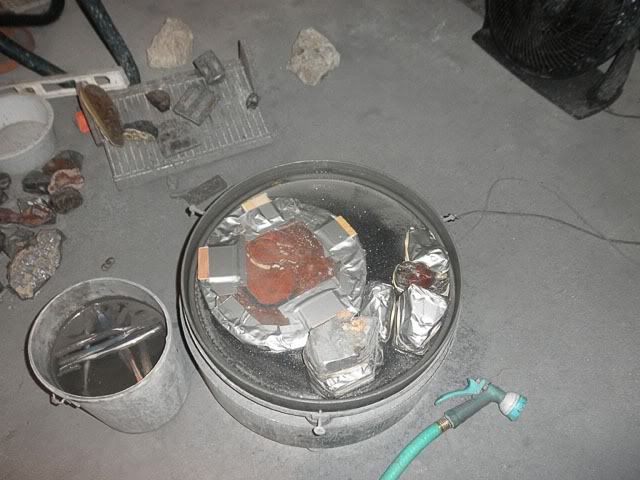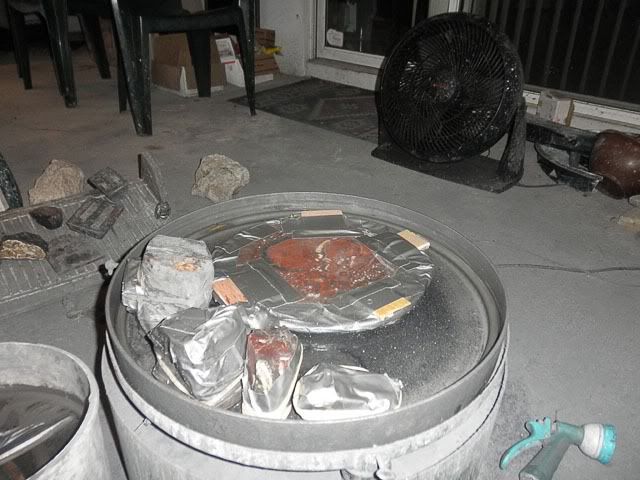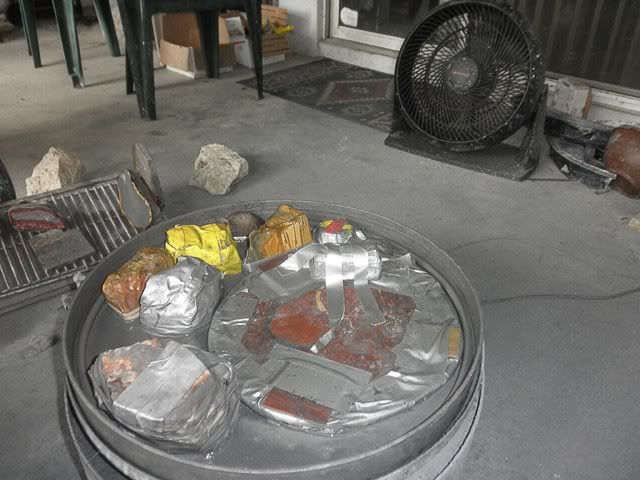rykk
spending too much on rocks
 
Member since September 2011
Posts: 428 
|
Post by rykk on Sept 20, 2012 20:29:10 GMT -5
Thought I'd up a couple of pix of Donnie's humongous Opal Butte slab being ground in my 20" Lortone "jiggle pan". This thing is really huge and could qualify as one of Earth's tectonic plates! 12 1/4" x 11 1/2". I taped 3/8" plastic tubing around the edge to protect it and the wood slats are there to keep the tubing from riding up over the edge when some other rock shoves on it. The slab isn't weighted because, heck, it already weighs7-10 pounds!   The big, tall chunk of Crazy Lace with the lead ingot strapped to one side is in there for 2 reasons. 1) Because it is super un-flat on one side due to the freaken nub/groove left on it by the seller and... 2) The biggest reason is to be sort of a "traffic cop". The big slab is really heavy and, without someone else in the pan of near weight, would tend to really throw its weight around and just sit in one spot if it - typically when you have one biggie and the rest much smaller - felt like it. The lace is heavy enough to push on the big slab enough that it has to take notice. The two really small rocks act as "wedges" that serve to also keep everyone moving. 16 hours later... So, after taking a look at the slab following an overnight grind with 60/90 grit, I noted that the slab was flattening out pretty well, except... One side is a bit heavier and also, the nub-groove and saw marks left by whomever cut this one, though present on opposing sides, are much deeper and extensive on one side of the slab. To compensate, I taped a 3lb lead ingot over this area that I'll probably remove after 6-8 more hours. This will, also, keep - to some extent - from grinding past the nice pattern in the center too much. I've had to do this a LOT with slabs because almost none of the ebay sellers take the time to knock off the nubs on their nodules or slabs. You end up using weights to sorta rock the slab end to end so that you don't have to grind a 16th of an inch off the whole thing to make up for the groove in front of the nub. On the other hand, it IS the "rough for cabbing" page and most folks probably buy chunks to cut cabs from rather than for polished specimens. Here's a pic of the "continental plate" slab with the weight atop and some new buddies in the pan since the others got good and flat overnight... Oh yeah, this rig has made a real mess of my back porch/lanai but it's worth it. And the fan is to cool ME, not to cool the vibe - and, also, to blow away the mosquitoes at night... and for cooling since this IS Florida and nighttime humidity means no respite after the sun goes down.  C-ya, Rick |
|
Deleted
Deleted Member
Member since January 1970
Posts: 0
|
Post by Deleted on Sept 20, 2012 21:02:26 GMT -5
Looks like you pretty much have that down to a science. I have heard good and bad about most flat laps but I have not heard anything about the jiggle machine. Looks like if a person works at it it will do the job. Thanks for the lesson.
Jim
|
|
rykk
spending too much on rocks
 
Member since September 2011
Posts: 428 
|
Post by rykk on Sept 21, 2012 2:16:28 GMT -5
Ok - 3 hours on the other side to grind down the saw marks there and now moved to dead center to run until morning to make sure the slab is still flat. A lot longer grind than usual, especially using 60/90 grit rather than my usual 120 grit 1st grind but I reckon it is because the slab has so much more surface area to flatten than usual.
C-ya,
Rick
|
|
|
|
Post by johnjsgems on Sept 21, 2012 7:39:09 GMT -5
Too bad you don't have a flat cabber or other way of removing the nubs first. It would speed things up. Have you tried using bumper rings without all the tape? It must be a pain replacing all that each step. I had a Lortone years ago and I used braided hose rings around mine with no issues. As I recall, I ground nubs off as best I could with a grinding wheel if the piece wasn't too large.
|
|
|
|
Post by Donnie's Rocky Treasures on Sept 21, 2012 9:37:42 GMT -5
Thanks for the update & the pictures!! Looking forward to seeing it finished!
|
|
|
|
Post by FrogAndBearCreations on Sept 21, 2012 9:46:03 GMT -5
you know what would work for the nubs and high spots, it would be the hand tool grinder they use on granite counter tops to work out defects, kinda like a hand sander for working wood but using diamond pads
|
|
|
|
Post by johnjsgems on Sept 21, 2012 12:01:00 GMT -5
Another idea if rock isn't too hard. They look like sharpening stones for knives and with the ceramic tile stuff at Home Depot. The diamond ones would be better and are called "diamond hand pads". You would need the coarser grits in metal bond. Maybe through a large tile place or a counter top supply.
|
|
rykk
spending too much on rocks
 
Member since September 2011
Posts: 428 
|
Post by rykk on Sept 21, 2012 16:24:35 GMT -5
John - I do have an 8" Inland spinner lap that I wear out far too many 100 grit disks on grinding nubs rather than cabs.
As far as other methods to remove the nubs, actually the typ. 1/8" wide and really deep groove that occurs just before the nub left when the slab/nodule half breaks off is the biggest problem. When I build my saw, it will have a feature I've designed or will design, depending on which method I go for, to keep this from happening. I have been told that one way to stop this is to slow the feed way down at the end of the cut. I haven't been able to test it but, given I'd know my feed rate and could measure the length of the cut, it wouldn't be too hard to design a timer circuit that could be set to lower the voltage to my feed motor after a certain amount of time. Especially since my feed will be digitally controlled anyhow.
Donnie's slab had a giant nub on it - naturally since it is huge - but I was able to grind it off. Took some doing as it was like 3" long, 5/8"-ish wide and a good 1/2" tall. The biggest problem with it is that either the saw vise "walked" at the beginning of the cut - something I've seen using the 18" Lortone at the local rock/gem club - or the flange washer was too small for a thin lapidary blade and the blade sorta flexed at the beginning of the cut. Maybe due to the sharply slanted shape of the nodule edge. This is, along with the surface area of the slab being so large, one of the reasons the rough grind is taking so long on this beautiful beast of a slab. You can pretty easily see by looking at both sides that this slab was probably one just before the heel/end cut. I have an idea how to prevent this junk on the saw I build, as well, but it's sorta iffy if I can pull it off without it being something that wears out a lot..
I can't begin to imagine how big this Opal Butte Jasper nodule was but sure wish I had a slice like this one. I think I've seen "westcoastgems" on ebay listing some that were like 8-12lbs+ but this thing had to weigh over 50lbs when it was dug up.
Later,
Rick
|
|
rykk
spending too much on rocks
 
Member since September 2011
Posts: 428 
|
Post by rykk on Sept 21, 2012 16:35:02 GMT -5
John - I tried using rings once but found that they get pushed up and off of slabs or "poor man's nodges" by anything adjacent that doesn't have a perfectly vertical edge. The tubing is just too light and just about anything, including the rock it surrounds, can get up under and lever it off if it has a slanted/angled edge.
Actually, these pix show me committing a no-no which is not covering the entire surface of the nodules/chunks in duct tape. I was able to do this only because the slab is so big that its "jiggle buddies" can't change the position/order they are in. They can rotate but not change positions with each other. So, I was able to save some tape by just doing every other one.
C-ya,
Rick
|
|
rykk
spending too much on rocks
 
Member since September 2011
Posts: 428 
|
Post by rykk on Sept 22, 2012 23:46:19 GMT -5
Ok, the second side of the slab only took around 12-14 hours. Looks like the saw blade or vise didn't walk on this side. Or I was able to grind them off on my flat lap and don't remember. It did have the nub and groove on this side but I stuck the approx. 3 or 4 pound lead weight right over that spot but perpendicular (if such is possible with a near circular shape - lol) rather than parallel to the edge to spread some of the weight towards the center and also a couple of 1.5 pounders taped to a veneer wood slice in the center. I took the edge weight off for the last 4-5 hours or so and left the weights in the center in place so as not to end up with an angled surface. Did the ol' pencil grid test and it looks dead flat.
The first side took right at about 48 hours due to the saw marks on 2 edges and the fact that I couldn't see how angled they were for a while and didn't weight down those spots until halfway through.
I spent another 6-8 hours letting some of the rocks that spent the night with the big guy grind. One is a 9" x 6" slab of Teepee Canyon agate that got WAY out of whack when the blade on the rock club's Lortone shifted (needs the right flange and shims) and also the vise walked. I tried to cut from the other direction to fix it but the vise walked again after they "fixed" it and I've had that slab in rough grind whenever there's room probably close to 200 hours. It was about 1/8" high in the middle and is still not quite flat as my pencil marks still extend a good inch in from both ends of it. It's an incredible slab with a number of full patterns across it that I cut from a chunk I'd bought and is worth the effort because I'm sure I'd never be able to afford one that big and nice.
I was going to leave off of the big Opal Butte Jasper slab and recharge the pan and grind the Teepee Canyon over night but figured I'd best stick with the program and keep up work on Donnie's slab. So, it's on to 220 grit for the side that finished 60/90 this AM. I figure I'll run each side of it around 20 or 24 hours just to make sure it's good and ready for the fine grit jiggles when I get to those. I could probably get away with a lot less because Oregonian thundereggs and their matrices polish really well and quickly with this vibe lap. But - the old adage - the longer you run the rougher grits, the better the shine and the less time required on the fine and polish phases... at least that's what they say - lol. So I'll have to tamp down my impatience and put in the time like I should.
C-ya,
Rick
|
|
















